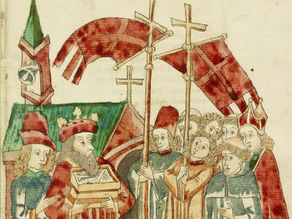top of page



The images “not made by human hands”
The acheiropoieton of Gethsemane as depicted in the manuscript Madrid, Biblioteca del Monasterio de El Escorial, T.I.1 (ca. 1280-1284), f. 44r, https://rbme.patrimonionacional.es/s/rbme/item/11337#?c=&m=&s=&cv=95&xywh=-4400%2C-263%2C12014%2C5244 . Legends surrounding so-called images “not made by human hands” ( acheiropoieta ) emerged around the 6th century, with the aim of popularizing the miracles attributed to them, promoting their veneration, and increasing the number o
Daniel Oltean
Nov 116 min read


The mystery of the Apostle John: asleep, taken up to heaven, or risen?
Giotto, Ascension of Saint John the Evangelist , Peruzzi Chapel, Santa Croce, Florence (14th c.), https://commons.wikimedia.org/wiki/File:Giotto_di_Bondone_-_Scenes_from_the_Life_of_St_John_the_Evangelist_-_3._Ascension_of_the_Evangelist_-_WGA09300.jpg . After the death of the Apostle and Evangelist John (late 1st century), his tomb did not become a place venerated by Christians, and later generations forgot its exact location. The oldest biography of the apostle only mention
Daniel Oltean
Sep 145 min read


The image of Edessa
The image of Edessa in the manuscript Paris, BNF Lat. 2688 (13th c.), f. 75r, https://mandragore.bnf.fr/mirador/ark:/12148/btv1b8101682k/f61 . In the Byzantine world, the icon of Edessa was arguably the most famous image “not made by human hands” (acheiropoieton). According to legend, before his death, Christ imprinted the image of his face on a cloth, which he sent to King Abgar V of Edessa with a letter. This story is not credible, especially since, unlike other Christian
Daniel Oltean
Aug 317 min read


Losing your head and finding it again
The Martyrdom of the Three Children Ananias, Azarias, and Misael, as depicted in the manuscript Vatican, BAV gr. 1613 (10th/11th c.), f. 251 (detail), https://commons.wikimedia.org/wiki/File:Ananias,_Azarius_and_Misael_(Menologion_of_Basil_II).jpg . In ancient times, losing one’s head was not an exceptional occurrence. Wars, conflicts of all kinds, and punishments could easily result in death by decapitation. Among those condemned to this type of death, hagiographic texts pr
Daniel Oltean
Jun 296 min read


Prince Siddhartha Gautama in the Christian calendar
The translation of Josaphat’s relics by King Barachiah, as depicted in the manuscript Los Angeles, Getty Museum, Ludwig XV 9 (15th c.),...
Daniel Oltean
Jun 285 min read


A journey to the centre of the Earth
Image of Thecla on a Coptic eulogy ampulla (6th/7th c.), Paris, Musée du Louvre, Département des Arts de Byzance et des Chrétientés en...
Daniel Oltean
Mar 215 min read


The Byzantine Synaxarion and the Liturgy of the presanctified gifts
The synaxarion of Pope Gregory I in the manuscript Sinai Gr. 548 (10th c.), f. 142r, https://www.loc.gov/resource/amedmonastery.00279380...
Daniel Oltean
Mar 196 min read


The legend of Emperor Theophilos
Emperor Theophilos and his court, as depicted in the manuscript Madrid, Gr. Vitr. 26-2, 12th c. (Chronicle of Skylitzes), f. 42v,...
Daniel Oltean
Mar 176 min read
Subscribe
bottom of page